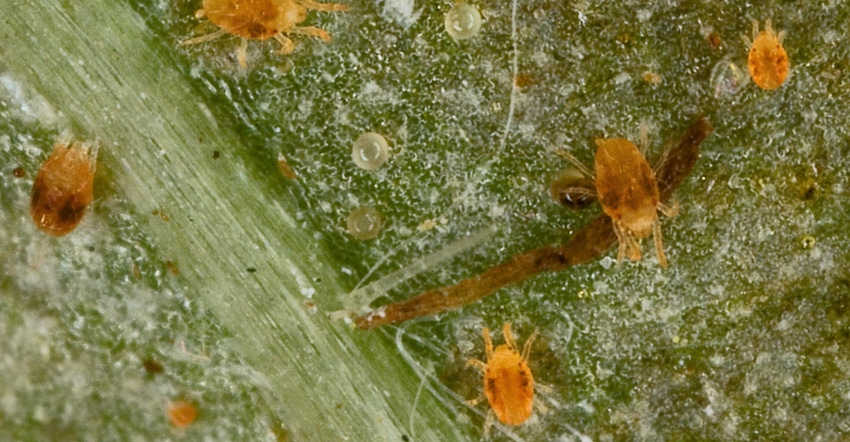
The hot and dry weather experienced by the north-central portion of Illinois in July hasn’t slowed down insect and pest damage. If anything, the conditions set the stage for corn rootworm damage to affect the crop more severely, says University of Illinois entomologist Nick Seiter.
“When you harm the roots, the plant’s even less able to take up the water that it needs to overcome the heat,” Seiter says of drought-like stress in portions of the state during the first few weeks of July.
Wetter and humid conditions set in for much of western and central Illinois by mid-July. Still, pockets of consistent dryness make spider mites a potential concern in soybeans, says Springfield-based Pioneer agronomist Matt Montgomery.
“In the western part of the state, where it’s been wetter — not to say that spider mites won’t happen, but your chance of running into that is decreased. Whereas, it’s pretty dry around Normal [Ill.], for instance. Conditions like that are primed for spider mites,” Montgomery says, calling insect and mite pressure a mixed bag that depends on variable weather conditions.
In the first and second weeks of June, Seiter says, there was spider mite pressure in southern Illinois “earlier than we normally would expect” because of consistent dry and hot conditions then. Yields in soybeans can be affected by the pest most severely in the pod-filling growth stages of R4 to R5.
“You can have spider mite issues at any time if the conditions are right,” Seiter says.
Insecticides like dimethoate are effective against mites. Miticides like abamectin are especially effective.
“None of the materials we have that are effective for mites last very long. You want to scout for pests and treat for them specifically,” Seiter says, adding it pays to intervene if 10% to 15% of the leaf area of soybeans turns brownish during pod fill stages and later. If the crops are still vegetative, they can take 25% browning.
Spider mite infestations start at the edges of a field. Seiter says this is sometimes because of mowing, which, if done when conditions are hot and dry, pushes the pest into the field.
“Then, if you have a broad-spectrum insecticide application that goes out when it’s hot and dry, you can take out beneficial insects,” he says. “That can actually, in some cases, result in a spider mite outbreak, too.”
Corn borer issues
Seiter says non-GMO corn farmers are reporting corn borer pressure. Montgomery says without the Bt trait for resistance, as the weather gets a little drier, survivability of European corn borer increases and puts yield in harm’s way.
“You’ll see more of a yield impact with corn borer in dry areas,” Montgomery says. “If I impede the plumbing of the corn plant, and yet I’m in a rain-inundated area, the relative yield impact is not as noticeable as it would be if I were dry.” He references the tail end of 2013 as an example of a dry spell that caused non-Bt-traited corn to yield substantially lower than corn-borer-resistant corn.
“We saw sometimes double-digit impacts on yield,” he adds. “We crank up the yield impact because the plant is under stress anyway.”
Montgomery says many of the farmers he works with use corn-borer-resistant hybrids. The biggest concern for farmers in his area of western Illinois is pressure from foliar diseases.
“We’ve had a lot of moisture, a lot of humidity. And you’re kind of holding your breath, waiting to see what July decides to do to us,” he concludes.
About the Author(s)
You May Also Like




